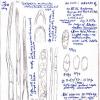
18-12-2025 21:17
Pol DebaenstThe identification took me to Byssonectria deformi

15-12-2025 07:09
 Danny Newman
Danny Newman
indet. Rutstroemiaceae sp. on unk. fallen leavesMc

19-12-2025 10:10
Patrice TANCHAUDBonjour, récolte réalisée en milieu dunaire, a

18-12-2025 17:23
 Bruno Coué
Bruno Coué
Bonjour,je serais heureux d'avoir votre avis sur c

18-12-2025 18:07
Margot en Geert VullingsThese plumes were found on rotten wood.They strong

17-12-2025 18:35
 Michel Hairaud
Michel Hairaud
Bonjour à tous/Hi to everyone I am passing along

15-12-2025 15:48
 Danny Newman
Danny Newman
Melanospora cf. lagenaria on old, rotting, fallen

15-12-2025 15:54
 Johan Boonefaes
Johan Boonefaes
Unknown anamorph found on the ground in coastal sa

15-12-2025 21:11
 Hardware Tony
Hardware Tony
Small clavate hairs, negative croziers and IKI bb
Hyalopeziza nectrioidea
Hans-Otto Baral,
30-01-2015 17:41
 Hi all
Hi allA solution was achieved today concerning a strange record that I presented in Ascofrance some months ago. It was on Rhododendron twigs from the Alps and looked hyaloscyphaceous though I considered also an encoelioid relationship:
http://www.ascofrance.fr/search_forum/30999
Now, today I received a sequence gained by Guy Marson from apothecia. It is a surprise, see above. This is astonishing since there was no glassy wall thickening to be seen at the hairs. Also the apothecia are described as whitish or brownish, with white hairs (Raschle 1977, Galán et al. 1997). But such brown exudate is also known from Protounguicularia (Olla) transiens, and also there the glassy cap is often absent in a major part of the hair tips.
There is not doubt because in the ITS region there is only 1 nucleotide difference to the sequence of Han & Hosoya et al. 2014 in GenBank, for which I do not know an illustrration, however. In their analysis it clusters with Hyalopeziza (Hyaloscypha) leuconica and Olla millepunctata.
In 1998 I had studied the sample of Ricard Galán and made the attached drawing.
Summarizing, I would never have managed to identify this collection without a sequence, not even at the genus level!
Zotto
Stip Helleman,
30-01-2015 19:06

Re : Hyalopeziza nectrioidea
Hoi zotto,
that is surprising indeed, I had also no idea. About the outcome of Han et al, I did not compare it but two days ago I had the same result in my tree, probably the same Genbank sequences are used.
Stip
that is surprising indeed, I had also no idea. About the outcome of Han et al, I did not compare it but two days ago I had the same result in my tree, probably the same Genbank sequences are used.
Stip
Hans-Otto Baral,
30-01-2015 20:29

Re : Hyalopeziza nectrioidea
Yes, this is the Japanese sequence in your tree. It seems to make sense that leuconica and nectrioidea are related since their glassy hair wall is similar. But H. nectrioidea is drought-tolerant, leuconica not.
I wrote to the Japanese athors hoping to see their documentation.
I wrote to the Japanese athors hoping to see their documentation.
Hans-Otto Baral,
31-01-2015 17:43

Re : Hyalopeziza nectrioidea
I need to make a correction: I had not looked exactly at the sequence in GenBank, it was made from a culture of Raschle, so it is a collection from the Alps, not Japan. And it was on Alnus, not Rhododendron as other samples by Raschle. So it seems herewith confirmed that the species is not host specific as already asserted by Raschle 1977.
Stip Helleman,
01-02-2015 00:11

Re : Hyalopeziza nectrioidea
yes that is quite hidden in Genbank, now you should write Raschle for documentation.
Hans-Otto Baral,
01-02-2015 08:20

Re : Hyalopeziza nectrioidea
Yes, Raschle fugured only the type on Rhododendron. But most of his samples were on Rhododendron. He says that the wall thickness is very variable, but a certain glassy thickness was apparently always there. In any case, I did not see wall thickenings at all, and the genetics show identity, even between the different substrates.
Raschle long ago stopped working on ascos and does other business, maybe with wood-destroying in houses, I remember. :-(
Raschle long ago stopped working on ascos and does other business, maybe with wood-destroying in houses, I remember. :-(


